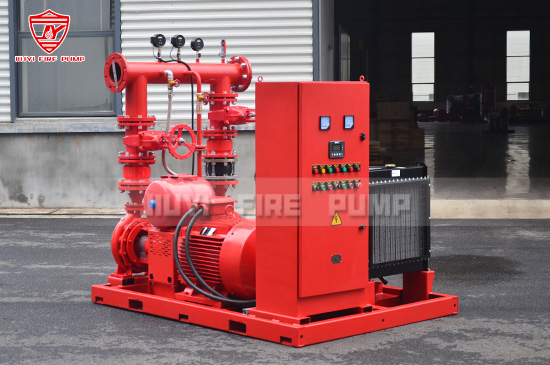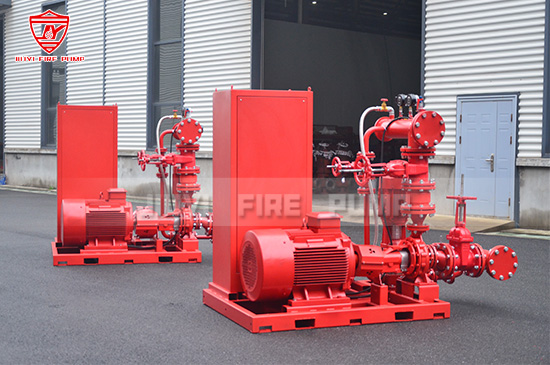When it comes to fire safety, ensuring your fire pump system is in optimal working condition is a critical task. Fire pump inspections are an essential part of maintaining your system's reliability, and knowing how long the inspection will take can help you plan and minimize disruption to your operations. But how long does a fire pump inspection actually take?
The length of time required for a fire pump inspection can vary based on several factors, including the type of fire pump, the complexity of the system, and the experience of the technician. In this article, we'll break down the factors that affect the time needed for a fire pump inspection, what you can expect during the inspection process, and how you can prepare for it.

The duration of a fire pump inspection depends on several factors that can either speed up or slow down the process:
Type of Fire Pump
Electric Fire Pumps: These tend to be faster to inspect since they have fewer components that need to be checked compared to diesel-powered pumps. However, testing the electric system and motor can still take some time.
Diesel Fire Pumps: Diesel engines require more thorough inspections. Technicians need to check fuel levels, engine health, and exhaust systems, which can add time to the inspection process.
Jockey Pumps and Auxiliary Pumps: These smaller pumps are often checked in a shorter timeframe but still require specific tests to ensure their functionality.
System Complexity
Standalone Systems: A basic fire pump with no additional components like controllers or monitoring systems may take less time to inspect.
Integrated Systems: Fire pumps that are integrated with more advanced systems such as SCADA (Supervisory Control and Data Acquisition) or monitoring systems take longer to test and evaluate, as the technician must ensure the entire system works as intended.
Vertical Turbine Fire Pumps: These require more complex inspections, especially when they involve deep installations or pumps that are difficult to access.
Maintenance History
Regularly Maintained Systems: If the fire pump has undergone regular maintenance and inspections, it will likely take less time to check, as many of the components will already be in good working order.
Systems with Neglected Maintenance: If the system has been poorly maintained or neglected, the inspection may take longer, as technicians will need to check every aspect carefully to identify any underlying issues.
Access to the System
If the fire pump is installed in an easily accessible location, the inspection will be quicker. However, if it's in a remote or difficult-to-reach area, the technician may spend additional time just getting to the equipment.
Inspection Scope
Some fire pump inspections are basic checks, while others may involve a full diagnostic of the pump’s system, including flow tests, motor checks, and performance evaluations. A comprehensive inspection will naturally take longer.

Regardless of the type of fire pump, all inspections generally follow a similar structure. Here's what you can expect during a typical inspection:
The technician will first perform a visual inspection of the fire pump, checking for any signs of physical damage, leaks, or wear. This includes checking the housing, bearings, and connections. The visual inspection will help identify obvious issues that may require immediate attention.
The technician will test the pump’s operation, ensuring it starts up and shuts down smoothly. The pressure, flow rates, and functionality of the pump will be tested to ensure the pump can deliver the required water flow and pressure in an emergency.
For electric fire pumps, the technician will check the motor, wiring, and control systems. This test ensures that the electrical components are functioning properly and that the pump will engage automatically when required.
Diesel fire pumps require additional checks. The technician will inspect the engine for oil levels, fuel condition, and general engine health. A diesel engine’s performance is crucial to fire pump functionality, so the inspection will be more thorough.
One of the most critical parts of the fire pump inspection is the flow and pressure test. This test ensures that the pump is capable of providing the required flow and pressure needed for fire suppression. The technician will typically run water through the system to confirm its ability to perform during an emergency.
The technician may also calibrate sensors and controllers to ensure the pump’s control system is properly configured. This is especially important in integrated systems or automated pump systems that depend on accurate readings.
Once the inspection is complete, the technician will provide a detailed report documenting the findings. This report may include recommended repairs, maintenance tips, or upgrades if the fire pump is found to be below standard.
Simple Inspections: A straightforward inspection of a basic fire pump may take about 1-2 hours. This includes visual checks and basic operation tests.
Comprehensive Inspections: If the inspection includes thorough testing of flow, pressure, and the full range of mechanical and electrical components, the process can take between 3-4 hours.
Large or Complex Systems: For more complex systems or pumps integrated with monitoring or SCADA systems, the inspection may take a full workday or more. This is common for large commercial or industrial setups where there are multiple pumps or specialized equipment.
In some cases, the technician may need to perform repairs or replacements during the inspection, which could extend the time required.

To ensure that the inspection goes smoothly and is completed on time, here are a few steps you can take to prepare:
Clear Access to the Pump: Make sure the fire pump is easily accessible for the technician. Remove any obstructions that could delay the inspection.
Provide System Documentation: If possible, provide any documentation about the system's history, including previous inspections, repairs, and upgrades. This helps the technician identify areas that may need extra attention.
Ensure Proper Safety Protocols: Fire pump inspections can involve testing the pump's functionality under pressure, so ensure that all necessary safety precautions are in place before the technician begins.
Allow for Extra Time: If the inspection is comprehensive or involves repairs, it’s a good idea to allow extra time in case any issues are discovered that need to be addressed.
The time required for a fire pump inspection can vary depending on the type of system, its complexity, and its maintenance history. On average, inspections can take anywhere from 1-4 hours, with more complex systems requiring additional time. Regular inspections are crucial for ensuring your fire pump remains operational and reliable in case of an emergency.
By understanding the inspection process and the time it takes, you can better prepare your system for inspection and ensure that it meets the necessary standards for fire safety.